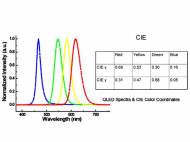QD Vision and LG team up on QLED displays development
 QD Vision, Inc. and LG Display announced a joint development agreement focused on creating highly-efficient, high-performance active matrix displays based on electroluminescent quantum dot LED (QLED) nanotechnology. Quantum dot light emitting diodes (QLEDs) represent an advanced electroluminescent technology that shows the potential to be used for the next generation of electronic displays and solid-state lighting applications.
QD Vision, Inc. and LG Display announced a joint development agreement focused on creating highly-efficient, high-performance active matrix displays based on electroluminescent quantum dot LED (QLED) nanotechnology. Quantum dot light emitting diodes (QLEDs) represent an advanced electroluminescent technology that shows the potential to be used for the next generation of electronic displays and solid-state lighting applications.
“LG Display has always been at the forefront of advanced display technology. This partnership with QD Vision will accelerate development of exciting new LGD products for the rapidly expanding display marketplace, and increase our industry leadership position”, said Chang-Dong Kim, Vice President of LG Display.
Today’s printable saturated QLEDs essentially match or exceed NTSC color standards for displays without the need for color filters. The excellent color performance of QLEDs ultimately translates into a 30-40% luminance efficiency advantage over the current organic light emitting diodes (OLEDs) at the same color point. Current OLED displays require lossy color filtering to achieve a similar color performance.
The luminous power efficiency of any LED is inversely proportional to its operating voltage. QD Vision’s recent research advancements in materials and device structures have led to very low operating voltage QLEDs, exhibiting turn-on voltages at the bandgap voltage of the material. Based on our measurement and analysis, when the exceptional color purity and low voltage operation of QLEDs are factored into the overall display power efficiency, QLEDs have the potential to be more than twice as power efficient as OLEDs at the same color purity.
QD Vision is developing quantum dot printing techniques with high material utilization to realize low-cost, full-color active-matrix displays and lighting devices. The ability to print QD emitters using a simple QLED device structure, without the need for color filters or a backlight, lowers the overall costs.
QLEDs are only a couple hundred nanometers thick, enabling its future applications to be virtually transparent and flexible, and highly suitable for integration onto plastic or metal foil substrates as well as other surfaces. These attributes will enable product designers to develop new display and lighting forms not possible with existing technologies.
“The continuing advances in nanotechnology at QD Vision are the key to a whole new generation of displays that are far superior to what is available today. Our relationship with LG Display will result in exciting new products that meet growing consumer demand for ultra–thin, high quality, energy efficient displays”, said Jason Carlson, QD Vision, Inc. President and CEO.
Although still in the early stages of commercialization, QLEDs can already be used in fields that require precise color solutions in an ultra-slim form factor, including monochrome visible and infrared displays, and lighting devices for machine and night vision applications.










Leave your response!